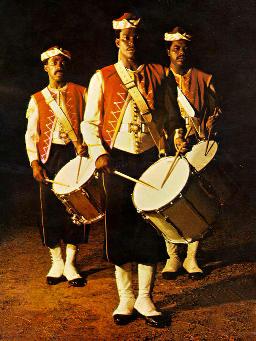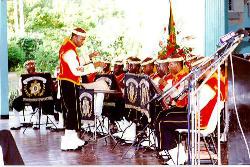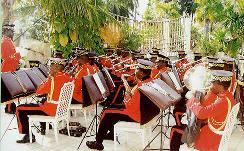 |
|||||||||||||||
| OVERVIEW – Music | |||||||||||||||
History The Role of Music Introduction Jamaica Military Band Jamaica Regiment Band
The affinity between music and the military dates back many centuries, indeed more than two thousand years ago a particular type of Greek heavy infantry traditionally advanced into battle to the music of flutes. Once the loosely coordinated groups of fighters of ancient times became more organised, first into disciplined bands and then proper armies, there soon developed a need for a better means of signalling commands in battle than merely the shouted words of the commanders. The obvious, indeed only answer at the time was the loudest and most portable musical instruments of the day. Early trumpets and especially drums naturally enough, came first, and also had the advantage of transmitting commands by simple code not familiar, at least initially, to the enemy. Coordinated marching also developed, both as a means of driving fear into the enemy by a show of highly disciplined advance into battle and also to better ensure timely and disciplined cross country movement of foot soldiers. An obvious corollary was then to keep time by beat of drum. A simple tune helped even more, and so the fife or its earlier counterpart was added to make the march more lively. Field Marshal the Viscount Montgomery of Alamein, in his ‘History of Warfare’, pointed out that in historical terms the Swiss armies of the late Middle Ages were the first modem soldiers to march in step to music. And so was born the Corps of Drums or ‘the Drums’ as it is colloquially known. Even today, when on parade with the Regimental Band, much more than the Bandmaster, ‘it is the Drum Major carrying his staff at the head of the. parade and wearing his drum belt embroidered with the badge and battle honours, who embodies the regiment’s spirit and history more than any other man present’, as was elegantly expressed in Arthur Taylor’s publication ‘Discovering Military Traditions’. The bugle arrived with the introduction of fight infantry, whose style and speed of movement could not accept the then standard musical instrument, the encumbering drum, for giving orders and signals. What of the military band itself with the wealth of music, especially marches, that have been written for it? In the British and Commonwealth tradition, until the mid-eighteenth century infantry regiment bands comprised hired civilian musicians whose wages were paid by the officers and who frequently were foreigners with unsatisfactory discipline and attitudes. From 1749 however, enlisted soldiers became the bandsmen. At that time the ancient fife, which had long gone out of favour, was re-introduced and in due course the drum and fife band became a norm. Other instruments in the early days of the true military band were one similar to today’s oboe, and in some regiments the French horn, the clarinet and the bassoon – and of course the ubiquitous drum. These early bands had a very small complement, often only six or eight men headed by a drum major – all a far cry from today’s full regimental band with up to thirty-five bandsmen and its wide range of brass and wind instruments. There are 2 bands in the JDF which play at State occasions and military events. Musicians also take on an operational role, usually as Medical Assistants. There are two military bands in the JDF – the Jamaica Military Band (JMB) and the Jamaica Regiment Band (JRB). Their musicians represent much of the public face of the Jamaica Defence Force – not only in Jamaica, but in the wider Caribbean and beyond; they represent also the rich traditions associated with our country’s military history. Their musicianship – together with their precision and bearing and the splendour of their uniforms – captures the pride and glory of the JDF. These bands of the JDF are in every sense versatile, as their members are not only musicians but soldiers as well.
The Jamaica Military Band has direct descent from the first of the old West India Regiments, which was formed in 1795 in the Windward Islands of the Eastern Caribbean. One of two units drafted into this regiment was the Black Carolina Corps, the remnant of a British loyalist regiment in the aftermath of the American War of Independence. By 1799 there were twelve single-battalion West India Regiments, some of which were involved in the fierce West Indies actions of the Napoleonic Wars, and a few in the later Ashanti Wars in West Africa. From early in the 19th century they had been reduced in number until by 1888 there was but a single regiment. In 1892, a Jamaican, Lance Corporal (later Sergeant) William James Gordon of the West India Regiment received Britain’s highest, and very rarely awarded gallantry decoration, the Victoria Cross. Through much of the 19th century, what is now the Jamaica Military Band was the band of the original and last surviving regiment, and thus came by its almost unique ‘Zouave’ uniform (the only other unit in the world which wears it is the Band of the Barbados Regiment). This was first issued in 1858. It is said that at a review of French colonial troops, Queen Victoria had been impressed by the uniform of the Zouaves (light infantry of North African origin), and afterwards instructed that it be introduced into a regiment of her army. An adaptation of this uniform, unlike any other in the British Army before or since, became the full-dress uniform of the West India Regiments until the last of them was disbanded in 1926 for reasons of economy. It has been worn ever since by the members of the Band. The transformation into the Jamaica Military Band is in itself noteworthy. As the Band of the WIR, it gave its final performance at a reception at Trafalgar House in Kingston in early 1927, before Their Royal Highnesses the Duke and Duchess of York (later King George VI and Queen Elizabeth, the present Queen Mother). The bandsmen turned in their instruments after the performance, but fortunately sentiment prevailed and the band was revived on 27th February 1927 as the Jamaica Military Band. This band has performed in various Caribbean countries including Cuba and St Christopher & Nevis; several cities in the United States including New York, Chicago, Atlanta and Miami; and a number of cities in the United Kingdom, as well as at Britain’s famed Aldershop Military Display. The Jamaica Military Band has performed in every military tattoo in Jamaica since 1933. The Jamaica Regiment Band and the infantry regiment of which it is a part, have a long lineage, being directly descended from the ancient Jamaica Militia of 1662. As defender of Jamaica’s shores, this was the successor to Cromwell’s troops which had taken Jamaica from the Spaniards a mere seven years earlier. In 1660 the Monarchy was restored in England and, two years later when the Jamaica Militia was formed, there commenced an allegiance to the Crown that has continued through more than three centuries to the present day. There is also a link with the West India Regiment; in 1959, what is now the 1st Battalion of the Jamaica Regiment became the 1st Battalion of the briefly resurrected WIR, following the creation of the short-lived (British) West Indies Federation. It became the forerunner of the rest of the Regiment when, following the dissolution of the Federation, it was re-established as the 1st Battalion the Jamaica Regiment on 31st July 1962 – six days before Jamaica became an independent Nation. In 1962 the Band, which had previously been that of the WIR, became the Band of the 1st Battalion the Jamaica Regiment; following the creation of a 2nd Battalion in 1979, it was renamed the Jamaica Regiment Band, and serves both regular Battalions. The Full-dress uniform is a scarlet tunic with dark blue
trousers.
Copyright ©
Jamaica Defence Force, all rights reserved. |


